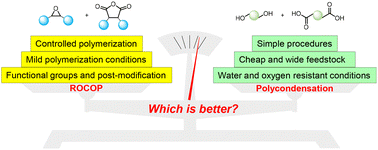A direct comparison between ring-opening copolymerization and polycondensation to produce polyesters using poly(ethylene succinate) as an example†
Abstract
Compared with the polycondensation of diacids (or diesters) with diols to produce polyesters, the ring-opening copolymerization (ROCOP) of epoxides and anhydrides is regarded as a promising alternative strategy because of its atom-economical characteristics, diverse monomer combinations, and facile tuning of properties. In this regard, a direct comparison of the two approaches is crucially important to better understand their pros and cons. In this article, by taking poly(ethylene succinate) (PES) as a template polyester, we performed a direct evaluation of ROCOP and polycondensation methods. For ROCOP, a series of mononuclear organoboron catalysts was utilized for ROCOP of ethylene oxide with succinic anhydride with high activities up to 608 h−1 at 150 °C within 0.5 h, affording PES with a low molecular weight of 3.7 kDa, while polycondensation of ethylene glycol and succinic acid produced PES with a high molecular weight of 28.1 kDa using antimony triacetate as the catalyst under vacuum at 200–280 °C within 11 h. In addition to the experimental results, the monomer preprocessing, polymerization conditions, post-processing, and total cost of the two strategies were roughly compared. On the basis of the comparison results, we cautiously make the point that ROCOP can hardly replace the polycondensation in the conventional polyester industry, but should be viewed as a complementary polymerization process that may find applications in preparing high value-added products (e.g., optically active polymers and block copolymers).

- This article is part of the themed collection: Pioneering Investigators 2023


 Please wait while we load your content...
Please wait while we load your content...